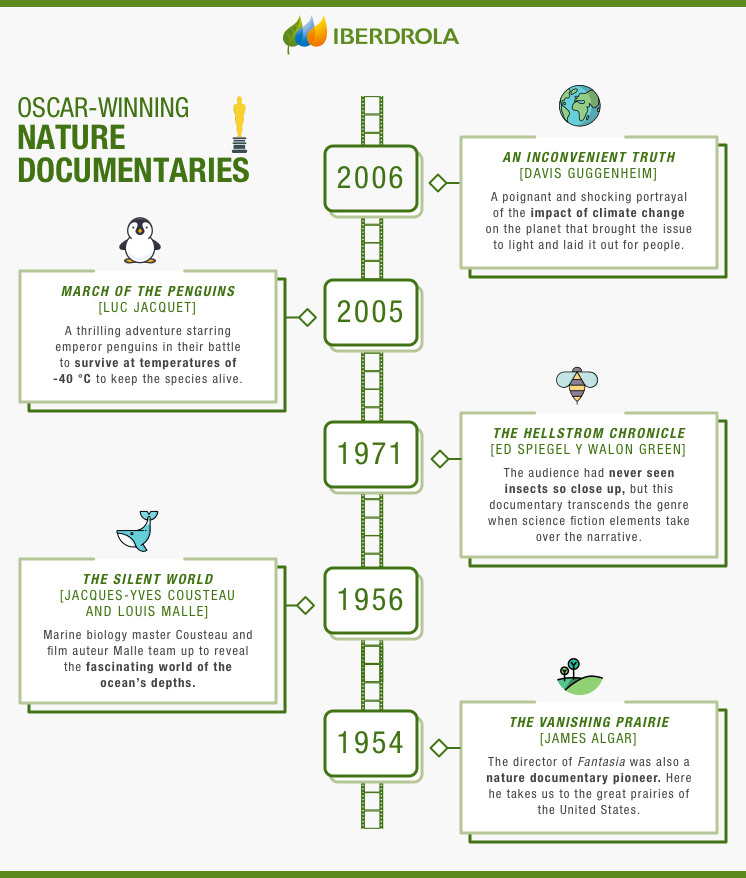CLIMATE CHANGE DOCUMENTARIES
Top ten nature documentaries to raise your climate change awareness
Documentaries have become one of our greatest allies in the battle against climate change. Actors such as Leonardo DiCaprio, politicians like Al Gore, artists such as Vik Muniz, musicians like Philip Glass and photographers such as James Balog have all engaged in this kind of projects to help raise awareness about a problem that is threatening the future of the coming generations.

CLIMATE CHANGE ON THE CINEMA
The documentary genre has become one of the most effective tools to raise people's awareness about the value of nature and the devastating effect that climate change can have — and indeed will have unless we stop it —. With such a complex phenomenon, it is possible and necessary to address it from different points of view. Fortunately, there are plenty of films out there that focus on illustrating the causes and consequences of climate change, as well as showing how precious our natural heritage is.
THE BEST DOCUMENTARIES ON NATURE AND CLIMATE CHANGE
Here is a look at some of the best documentaries dedicated to environmental topics, according to viewers and critics:
An Inconvenient Truth (2006), Davis Guggenheim
The first documentary to show the devastating effects of climate change. This film marked a turning point, as well as winning the Oscar for Best Documentary. Narrated by former US Vice President Al Gore, the film paints an unsettling picture of our planet under the threat of vast amounts of CO2 emissions due to human activity. The claim promised it to be "By far the most terrifying film you will ever see", and it still has an impact on people to this day.
On YouTube and Google Play.
Tomorrow (2015), Cyril Dion, Mélanie Laurent
Cyril Dion and Mélanie Laurent, the lead actress in Inglorious Basterds (2009), set off with a small team of four to visit ten countries and investigate the causes of climate change and, more importantly, how to prevent it. On their travels, they meet pioneers who are reinventing agriculture, energy, the economy, democracy and education. By the end, they can see a glimmer of hope for a new world.
Waste Land (2010), Lucy Walker
As Brazilian artist Vik Muniz works on an installation in Jardim Gramacho (Rio de Janeiro, Brazil), one of the world's biggest landfills, documentary director Lucy Walker films his work to show viewers what daily life is like for the people living there. The finished product combines ugliness and beauty in an unusual approach to raising awareness about excessive waste and how it affects global warming.
Before the Flood (2016), Fisher Stevens
A glimpse at the effects of climate change on our surroundings, from saving endangered species to find ways for society to prevent these effects by changing certain habits. Filmed over a three-year period, this documentary, produced and narrated by Leonardo DiCaprio, features interviews with global celebrities like Barack Obama, Ban Ki-moon and Pope Francis.
On Disney +.
Baraka (1992), Ron Fricke
Baraka is a Sufi word meaning 'breath of life', and this documentary is just that. Shot in 24 different countries, Fricke and his team manage to capture the essence of nature and how humans interrelate with the environment. Without needing to use words, this celebrated production succeeds in showing the destruction people can cause, while appealing to their spirituality as the crucial element in preserving our planet.

Home (2009), Yann Arthus-Bertrand
The documentary shows the harmful effects of mankind on Earth — in just 200,000 years of existence, humans have upset the balance of almost 4 billion years —, but it also warns us that it is too late to be pessimistic. Yann Arthus-Bertrand brings us never-before-seen images of over 50 countries seen from the sky in order to share his amazement at so much beauty and his concern for the future, calling on us all to take action and realise just how much our home is worth.
On YouTube.
Chasing Ice (2012), Jeff Orlowski
Acclaimed photographer James Balog, directed by Jeff Orlowski, ventures into the farthest depths of the Arctic to reveal the true extent of climate change. Over years they visited the most remote areas in Iceland, Greenland and Alaska in order to capture the phenomenon of melting glaciers and its staggering impact on nature. Watching huge chunks of ice come crashing down is enough to make even the most sceptical of viewers change their tune.
On Netflix.
Earth (2007), Alastair Fothergill, Mark Linfield
A fascinating journey across the Earth, from north to south through all four seasons, to portray the striking contrast that lies in all corners of the globe and its natural transformations. Conceived as a series, it was filmed for five years at over 200 locations in 26 different countries, and also released an abridged 96-minute version that selects the best footage. This documentary manages to show the beauty of the animal kingdom in all its glory, as well as warning that it is gradually deteriorating due to climate change.
Oceans (2009), Jacques Perrin, Jacques Cluzaud
The Earth is also known as the blue planet, since after all more than 70% of the surface is under water. After dazzling the audience with Winged Migration, Jacques Perrin and Jacques Cluzaud now take to the seas and oceans with the latest in filming techniques — they had a budget of over €50 million — to discover underwater creatures and campaign against the destabilising effect of human activity under the waves.
On YouTube and Google Play.
Koyaanisqatsi (1982), Godfrey Reggio
The unusual title of this 1983 documentary means 'life out of balance' in the language spoken by the ancient American Hopi tribe. It became the first production to warn of the impact of humankind on nature. Its powerfully moving images are enhanced by the music composed by Philip Glass. In 2000, the film was classed as 'culturally, historically and aesthetically significant' by the United States Library of Congress and was selected to be kept in the National Film Registry.




